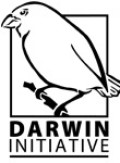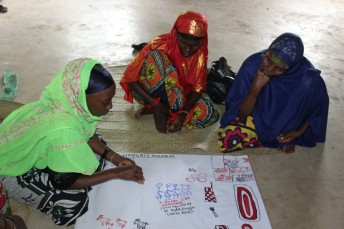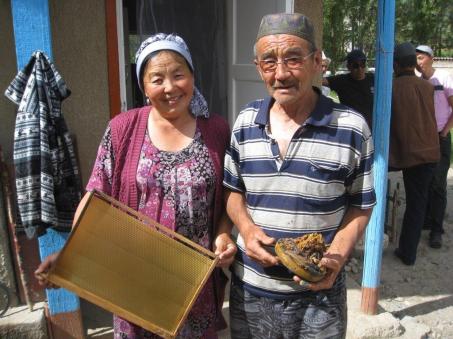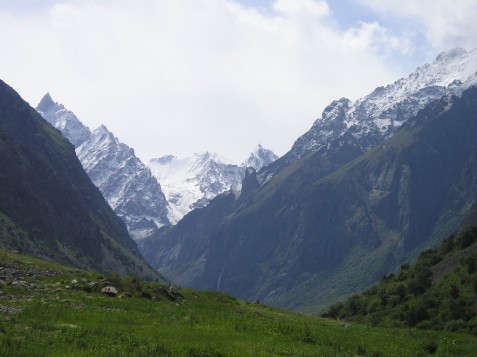For anyone who is involved with a Darwin project, the below probably won’t come as much of a surprise but for everyone else – have you ever wondered how we track how Darwin projects are getting on? It may be more exciting than you think!
Twice annually, we ask Darwin Initiative projects to submit reports (believe me, it gets more exciting…), updating us on their progress towards their expected outcomes and sharing any lessons or challenges. At any one time, there are over one hundred active projects (145 right now), quite a lot for any one person to get their head around! We rely on a team of experts with experience from all over the World and across a huge array of conservation and development themes – necessary to match the diversity of the Darwin portfolio.
As each project has its own context, barriers, and often innovative methods, writing a paper report that captures everything it needs to is a challenge in itself. And the reviewers have a job on their hands, too, using the report and evidence provided to independently verify and track project progress against the project’s logical framework, or logframe (see our information note on logical frameworks here). These reviews are then shared with the project, and can include recommendations to help the project team achieve their overall aims.
But, here’s where it really gets interesting. In addition to the dozens of independent, desk-based reviews carried out annually, it is valuable for both the programme as a whole, and for individual projects, to carry out a field-based review of a few projects at their mid-way point (i.e. at 18 months of a three-year project). Projects are chosen for mid-term reviews using a number of criteria and visited by an independent reviewer for a week-long field trip. These trips provide opportunities for progress, challenges and lessons to be discussed not just with the project team, but with project partners, stakeholders, and beneficiaries. This helps the reviewer gain a much better perspective of how the project is truly progressing.
This year, I was fortunate enough to be able to participate in such a review, and visited the beautiful country of Belize in November. One of the projects visited, “Maximizing Benefits of Marine Reserves and Fisheries Management in Belize”, is led by Wildlife Conservation Society and partnered with the Belize Fisheries Department, Environmental Defense Fund, The Nature Conservancy and the University of Miami. The project is part of a broader programme that is revolutionizing the sustainable fisheries management in Belize through “Managed Access” licensing and zoning of fisheries in Belize, and increasing the area under “no-take” zones, with a focus on lobster and conch fisheries.
The review team spent the week with the project team, discussing their key successes and barriers as well as watching them in action carrying out boat-based surveys at Glover’s Reef Atoll (find out more about WCS’s broader research programme at Glover’s here: http://www.wcsgloversreef.org/).

View from the watchtower at Glover’s Reef Research Station, Credit: Victoria Pinion
We also had the opportunity to meet with project partners, and a range of project stakeholders. For example, we were even invited into the home of Mr and Mrs Thomson, both fishers, who spoke to us about how the recent changes under the project, and broader programme, were affecting their livelihoods – and what they thought were the continued challenges to sustainable fisheries in Belize.
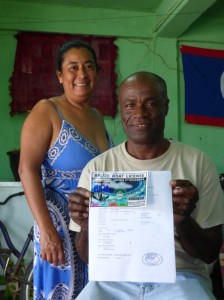
Mr. and Mrs. Thomson, both members of the Warafu Fishers Association in Dangriga, show off their boat license, Credit: Victoria Pinion
Big changes don’t come easily or quickly, and this project really demonstrates how proper engagement with stakeholder communities is crucial to success of rights based access schemes, and perhaps all conservation initiatives. We were particularly struck by one of the innovative tools the project uses to engage with the community, which has already been recognized by winning the Millbank Social Marketing Award for Innovation in the Environmental Field. “Punta Fuego” is a radio drama and call in show, and hugely popular across the country. It has just finished its second season, and has already changed the attitudes of those who listen to it to respect the no-take fishing zones being proposed under the project. The project team spoke to one fisher, who after listening to the first season said: “I will be honest, I used to fish in the [no-take] zones from time to time. Now I think about what I hear in the show and I don’t think I will be doing that again.” Listen to Episode 1 of Punta Fuego on YouTube: https://youtu.be/7f4qIqq4hGU

Vonetta Dawson (maybe Punta Fuego’s biggest fan!) shows off her “legal size” haul of red snapper ahead of the Garifuna Settlement Day celebrations on November 19th, Credit: Victoria Pinion
Visiting this project on the ground enabled us to generate wider lessons that could be shared with other projects, which is more challenging to do with just the desk-based reviews. Additionally, it provides an opportunity to feedback recommendations to the project about how they could make some small changes to improve upon what is already a fantastic project.
